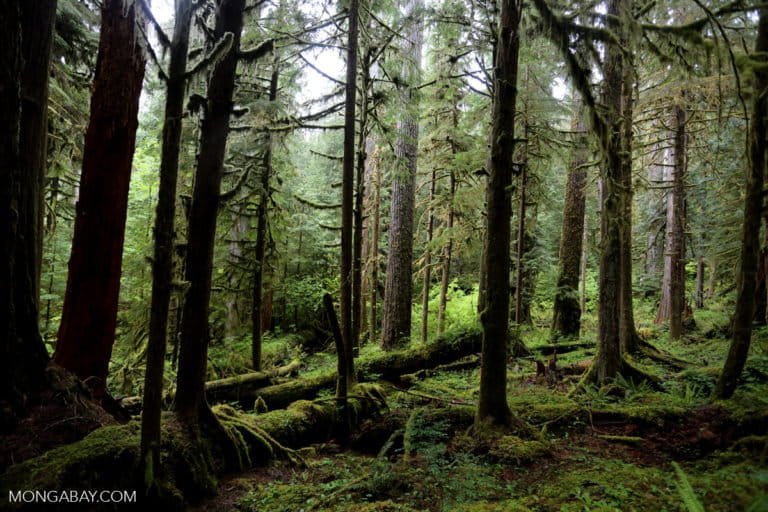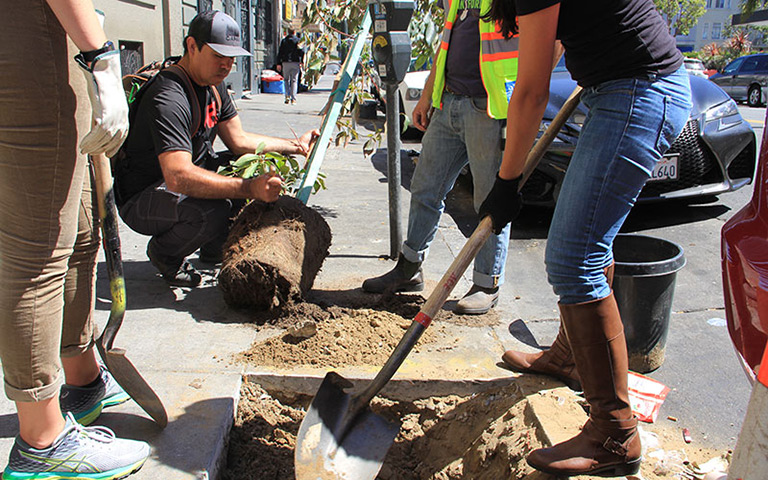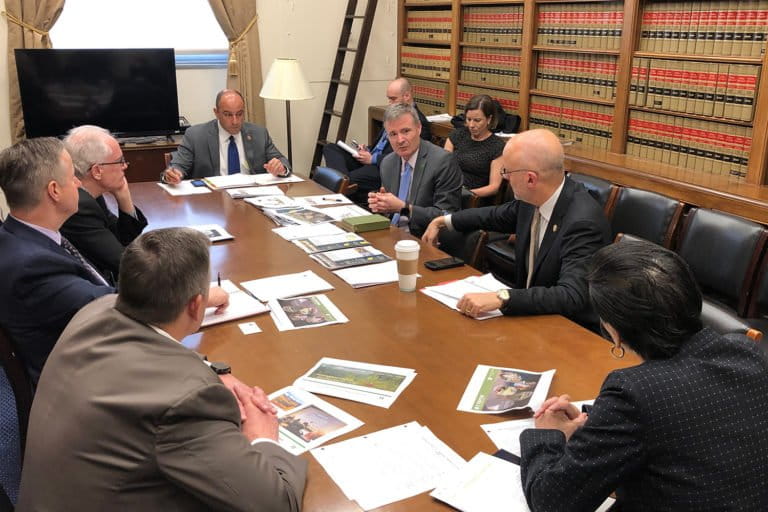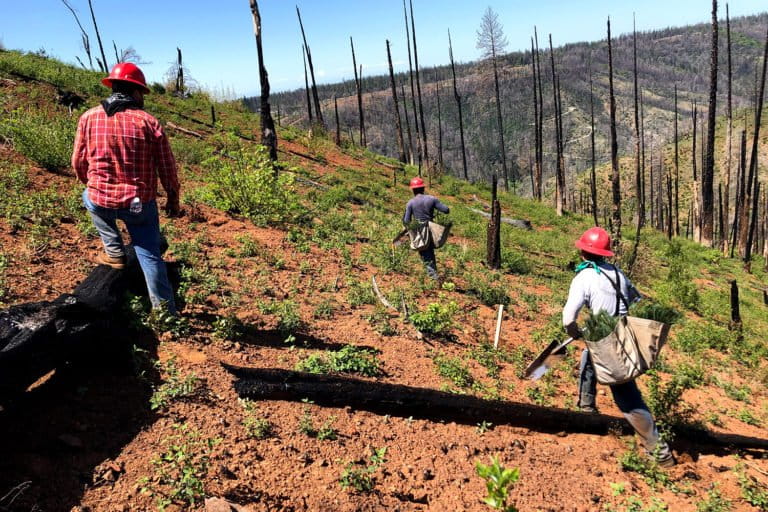- For nearly 150 years, the group American Forests has been at the forefront of efforts to protect woodlands across the U.S., institute sustainable forestry management, and, more recently, mitigate against increasingly severe wildfires.
- Its president and CEO, Jad Daley, says forests remain a viable solution to contemporary problems ranging from the pandemic-induced economic crisis to social injustice to climate change.
- Investing in forest restoration and urban forestry generates jobs, Daley says, while also contributing to carbon sequestration and providing sustainable timber.
- In this interview with Mongabay founder and CEO Rhett A. Butler, Daley says he wants the forest movement to be “a place that feels relevant and welcoming for everyone.”
In the decade following the end of the U.S. Civil War, a group of people led by physician and horticulturist John Aston Warder established the American Forestry Association to create a constituency for protecting the country’s fast-disappearing forests. The group advocated for better stewardship of forests, including the creation of forest reserves to maintain timber stocks, wildlife habitat, watersheds, and recreational areas.
In the near century-and-a-half since its founding, American Forests, as the institution is now known, has at times had to navigate periods of tumult. Rampant destruction of forests led it to organize the first American Forest Congress and the first annual National Arbor Day to build support for the concept of forest conservation. The economic hardship wrought by the Great Depression prompted it to push for the creation of the Civilian Conservation Corps. Timber stock depletion due to the Second World War moved American Forests to call for a national forest management strategy. Increased incidence and severity of forest fires this decade spurred the group to build a coalition to secure resources for preventing wildfires.
 Today Americans face a deluge of challenges, from political polarization to protests over social injustice to the economic pain caused by the COVID-19 pandemic to the growing impact of unchecked climate change. It seems like a particularly bleak moment for the country, but American Forests president and CEO Jad Daley says he believes that forests can again be part of the solutions to some of our biggest problems. For example, Daley sees forests playing an important role in post-pandemic recovery efforts by creating work opportunities and supporting efforts to rebuild crumbling infrastructure. By sequestering carbon, U.S. forests can help in the fight against climate change, while urban trees can help cool cities. And because conservation has traditionally enjoyed bipartisan support, Daley says he believes that forests can help bridge political divides, especially as the constituency for forests is broadened to include a wider array of people across society.
Today Americans face a deluge of challenges, from political polarization to protests over social injustice to the economic pain caused by the COVID-19 pandemic to the growing impact of unchecked climate change. It seems like a particularly bleak moment for the country, but American Forests president and CEO Jad Daley says he believes that forests can again be part of the solutions to some of our biggest problems. For example, Daley sees forests playing an important role in post-pandemic recovery efforts by creating work opportunities and supporting efforts to rebuild crumbling infrastructure. By sequestering carbon, U.S. forests can help in the fight against climate change, while urban trees can help cool cities. And because conservation has traditionally enjoyed bipartisan support, Daley says he believes that forests can help bridge political divides, especially as the constituency for forests is broadened to include a wider array of people across society.
Daley spoke about these issues and more during an October 2020 interview with Mongabay founder and CEO Rhett A. Butler.

Rhett A. Butler for Mongabay: What inspired your interest in forests?
Jad Daley: I had the incredible privilege to spend my summers growing up on an island in Maine. It is a mostly wild island, accessible only by boat, and my favorite thing to do was explore the fully forested north end of the island for hours at a time. Those trails are still some of my favorite places I have ever visited. As a young adult this connection deepened when I spent extensive time hiking the Appalachian Trail and other wild places in New England. That led me to an early career in forest conservation, working to conserve large forest landscapes in the eastern U.S. as the first director of the Eastern Forest Partnership.

What has been exciting is to experience my relatively narrow initial interest in forests broaden in new ways. This includes my growing fascination with forest birds, and my passionate belief that trees and forests can address the most searing societal issues, from slowing climate change through carbon sequestration to the power of urban forests to deliver climate justice and health equity in cities. That has in turn led a broadening of my interest from forest conservation to also include the more nuanced and complex issues of forest management and restoration. I am endlessly fascinated by the potential of great forestry to maximize forest benefits for issues like climate change. You can think of me as a proud “wood wonk.”
Mongabay: How did you come to lead American Forests?
Daley: My transition to American Forests was the culmination of a career-long journey in building and leading coalition efforts on forests, with a special emphasis on climate change. All of my previous roles included some aspect of this movement building, like forming and leading the Eastern Forest Partnership and co-founding and then leading the Forest-Climate Working Group. I have been fascinated my whole career at the complex challenge of building consensus among diverse interest groups, and then converting that into the power to enact policy and effect other needed actions.

American Forests has been rooted in this same kind of servant leadership and movement building. All throughout our history we have been rallying America together to identify what was happening in our forests, and what that called us all to do together. A little over three years ago I was concluding a very satisfying stint at The Trust for Public Land, where I had built the climate program and in parallel led the Forest-Climate Working Group. I felt that the nation and world were on the verge of a major rediscovery of our forests as critical infrastructure for our planet—from urban forests to wilderness—and that the forest movement was missing a certain kind of focused and unifying leadership as well as sufficient attention to key details of forestry that can deliver the outcomes we seek for carbon, social equity, and more. I was confident that American Forests could be that unifying force, bringing together leaders in science, forestry, and policy to capture this moment. I came to American Forests specifically to do that, drawing on the organization’s history and standing and bringing my own expertise, roles, and relationships, like leadership of the Forest-Climate Working Group, which we now lead from American Forests.
I am proud to say that this vision has come to fruition even beyond my greatest hopes, with our organization quickly providing diverse movement leadership beyond the Forest-Climate Working Group to also include launching the new U.S. Chapter of 1t.org, catalyzing a national movement for Tree Equity in our cities, and partnering with the 25 states of the U.S. Climate Alliance to help them integrate forests into their climate efforts.

Mongabay: American Forests has quite a storied history. What do you feel are some of the most significant moments?
Daley: American Forests has led substantive and lasting change when our forests needed it most. Here are some great examples:

Mongabay: Do you see an opportunity for forests to be part of the post-COVID economic recovery?
Daley: Absolutely. Trees and forests provide the greenest of green jobs, and most importantly for the people who need them most.
First some key numbers: Every million dollars invested in forest restoration generates 39.7 direct, indirect and induced jobs. That means investing in things like reforesting burned over areas in the West can put people in those impacted rural communities back to work. This is essential, because many rural economies were trailing even before Covid, and have suffered more during the downturn with fall-off in things like tourism. The same is true for urban forestry, especially when focused on Tree Equity for socially disadvantaged neighborhoods that are economically stressed. Every million dollars invested in urban forestry generates 25.7 direct, indirect and induced jobs.
This economic potential grows when we embrace forest products as a sustainability solution, from urban wood utilization to mass timber construction. Wood is renewable, stores carbon and requires less energy to manufacture than other materials. We need to embrace this potential, and the diverse jobs that come with it.
This incredible potential is why American Forests is leading a Career Pathways initiative that is filling in the missing gaps to make people aware of forest-related career opportunities, and to help them bridge into employment and stay there with tools like pre-employment programs and wrap-around services. This Career Pathways work is most advanced as part of our commitment to achieve Tree Equity in cities, building new sector partnerships with educational institutions and employers to leverage employment for people from lower-income communities of color.

Mongabay: Until relatively recently, some environmental issues, like public lands and wilderness conservation, had bipartisan support. Do you see opportunities for forests to unify politically divided Americans?
Daley: I truly believe that we are one nation under trees. You can see that even now, with widespread bipartisan support for bills like the REPLANT Act that would dramatically increase funding for reforesting our national forests when they die and burn, and the TREE Act that would use Department of Energy funds to help plant trees that naturally cool our neighborhoods, lowering demand for air conditioning. You also see strong bipartisanship on the response to our wildfire crisis, from the Fire Funding Fix that was enacted in 2018 to current proposals that would go even further address the rapidly escalating impact of climate change on wildfire risk.
I think it is essential to realize how much this matters for a divided nation, to have some things we can agree on. This is especially true with forests and climate change—the mere fact that both parties are agreeing to use forests as a climate change solution means we are actually talking about climate change solutions! If we can agree that climate should be addressed and find even one shared solution, that opens the door to much more in the future.

Mongabay: And along those lines, what would your strategy be to build a broader coalition of support so that everyone feels like the country’s forests are something that benefit them, whether they’re from the city or rural areas, or they identify as people of color?
Daley: American Forests has always believed the benefits of trees are important to everyone everywhere, especially in cities! But going farther by framing the urban forest imperative as Tree Equity, we are being explicit in linking our work to the crisis of social injustice and racism in our country. We name these issues clearly, including in our organizational statement on racism issued in June, and we are very explicit in trying to focus our own work and the urban forest movement on making trees one part of the broader equity and justice solution. Elements of our approach like the Career Pathways initiative are also important to this effort, because we are explicitly recognizing that addressing the inequities and structural racism in America is not just about environmental conditions like whether people have trees in their neighborhoods—it is also about having jobs. Living in a leafy neighborhood is not close to enough if you don’t have economic security, also.
Ultimately, I hope that our Tree Equity focus in partnership with amazing organizations, from frontline community groups to city leaders, is helping to make the forest movement a place that feels relevant and welcoming for everyone.

Mongabay: Due to their high rates of deforestation and carbon density, most of the focus on forests in the context of climate change mitigation is in the tropics. Now that tree-planting is getting a lot of attention, are temperate forests becoming a larger part of the conversation? What do you see as the biggest opportunities for American forests to help mitigate climate change?
Daley: Let’s be clear, America’s forests and forest products are a carbon powerhouse on a global scale. Our forests and forest products capture and store about 15 percent of our carbon dioxide emissions from fossil fuels each year—over 750 million Mt CO2e in net sequestration in the most recent annual GHG inventory—and strong, credible science says we could nearly double this with actions like reforestation, keeping forests as forests, wildfire risk reduction, and strategic use of wood products. However, there are also scenarios where we could actually lose this climate mitigation power, through forest mortality, wildfire and other forest health issues that are ironically and tragically being driven by climate change, and a projected increase in the amount of forests lost to development. America can’t win on climate change without our forests, and they actually hold the swing vote because of this potential to either help much more or ebb as a climate solution—depending on our actions.
When we started the Forest-Climate Working Group in 2007, this importance of U.S. forests for climate was not widely known. It seemed like all of the discussion on Capitol Hill and in the public was about tropical forests. That has really changed. The climate mitigation power of U.S. forests is finally understood, and we feel this increased support in our public policy efforts and many other ways.

Mongabay: Here in California, we’ve been suffering through devastating fires and horrendous air pollution the past couple of months. This seems like a problem that will only get worse as climate warms, droughts become more common and severe, and we continue to build in the wildland-urban interface. What’s the best way to address this issue?
Daley: This is often oversimplified to climate change vs. forest management. The problem actually has many layers, but it starts with slowing climate change AND changing forest management. Climate change is the underlying driver of our extreme wildfire risk. If we don’t turn off this engine of forest mortality and elevated risk factors (worse lightning storms, more high heat and wind days), we can’t get this right. But as I have written many times in many ways, climate change is already in motion from past emissions and will continue regardless. We must actively “pre-store” our forests for resilience to these changes already in motion with actions like more aggressive and innovative use of thinning and prescribed fire, and focusing forest management and reforestation to gradually adapt our forests to mix of tree species, genetics, and structural features like clumping so they can actually survive and thrive in a hotter drier climate that is bringing more stress from pests, disease, and wildfire.
Lastly, we must realize that this climate adaptation is also climate mitigation, because wildfire releases huge amount of carbon. This is a growing hole in our forest carbon sink that we must plug, a tragic example of a climate feedback loop.

Mongabay: For what’s usually thought of as an ancient technology, there is a surprising amount of innovation happening with wood, for example Cross-Laminated Timber (CLT). What are your thoughts on developments in this space?
Daley: You are right, the space age building material of the future is actually our oldest one: wood.
Wood is renewable, stores carbon and requires less energy to manufacture than other materials. We need to embrace this potential, and the diverse jobs that come with it. To put a fine point on it, in the latest US GHG Inventory, wood was responsible for almost 100 million Mt CO2e of carbon storage—making it about 13 percent of our total forest carbon sink. Add in the avoided energy use from wood, given its manufacturing efficiencies, and you can see that wood is good to act on climate!
But it is also good for healthier forests and communities. We can target wood utilization to places where we also need more active forest management, like fire prone forests in the West, and forests with naturally robust productivity like in the Southeast and Northeast. That means pulling out more wood for building can be synchronized to leave the forest in better condition. Wood buildings also mean healthier people! There is great data about the mental and physical health benefits of buildings that utilize wood versus other materials.

Mongabay: There is also potential environmental downside from emerging trends in wood consumption. For example, there is a push to expand biomass production for BECCS, which would potentially increase demand for biomass at the expense of natural forests, especially in the American south. How can the U.S. ensure the sustainability of the sector? Do you see opportunities to protect America’s old-growth forests from these risks?
Daley: Wood utilization for any purpose, including biomass, must take into account the originating forest and the end use. Every forest has a natural productive capacity that can maintain optimal forest health. Every end use has different efficiencies, especially with biomass, in terms of the potential used in wood that is harvested.
So biomass isn’t good or bad, the answer is “it depends”. It depends on finding those settings where the needed offtake of wood is in harmony with the health of the forest, and the end use is efficient in terms of haul distances and utilization of the energy potential in the material. One example I love is community-scale wood energy in New England, a region where I have lived much of my life. These forests need a lot of “timber stand improvement” to manage competition and foster optimal forest growth, and this offtake woody material is ideal for biomass to be used in applications like heating schools and switching whole neighborhoods from fuel oil to locally sourced pellets.
A great study from the Northern Forest Center, conducted by a respected group that has generally been skeptical of wood energy, showed that in one particular project of this type switching to wood pellets reduced carbon emissions by more than half. We should focus on finding win-win scenarios like this one.

Mongabay: What would you say to young people who are distressed about the current trajectory of the planet?
Daley: First of all, I would say, “Thank you.” When we win on climate, and we will, we will remember the bravery and tenacity of young people at this critical moment when the fight was in the balance. I feel pushed every day to live up to the standard of youth leaders around the world, and including my own niece, Riley Stevenson, an award-winning youth climate activist in Maine! I am truly blown away by the skills of today’s youth in organizing, communications, and getting deep into the serious details of climate action, climate justice, and more. They are performing every bit as well as, and often better than, their elders.
I would also say that there is a place for you in Forests4Climate, whether your cause is Tree Equity in cities, conserving and restoring forest landscapes, or innovating the next breakthrough wood product that replaces a non-renewable material with carbon-storing wood. Our sector is booming, and we will be creating millions more jobs from working in the woods to computer technology to public policy and community organizing. I hope more and more of the talented young people who are on climate will chose forests for a career, and I can say that American Forests is one of those organizations that continues to hire!
Lastly, I want to remind us all, youth included, that while forests are a powerhouse part of the solution to climate change as we explored extensively in this interview, they bring solutions to so much more that ails our planet–like the global biodiversity crisis and threats to our water security. That is one reason why trees and forests are such a powerful investment. We have youth stepping up on all of the issues we can address by conserving, restoring and growing forests, and we need everyone on board to deliver forest solutions, no matter what draws you most strongly to this cause.
